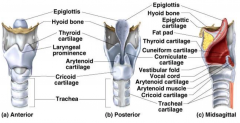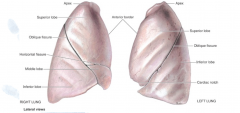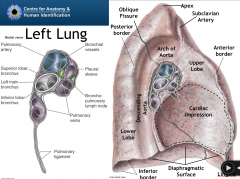![]()
![]()
![]()
Use LEFT and RIGHT arrow keys to navigate between flashcards;
Use UP and DOWN arrow keys to flip the card;
H to show hint;
A reads text to speech;
20 Cards in this Set
- Front
- Back
|
conchae |
folds of tissue on lateral wall of nasal fossa. Muscous membranes supported by thin scroll like turbinate bones |
|
|
meatuses |
narrow air passage beneath each concha. narrowness and turbulence ensure air contacts mucous membranes |
|
|
pharynx |
passage between nose mouth and larynx |
|
|
larynx |
passage for air between pharynx and lower respiratory path |
|
|
nine cartilages of larynx |

epiglottic thyroid cricoid arytenoid corniculate cuneiform |
|
|
trachea |
passage for air between thorax and exterior. from below larynx to carina (transverse thoracic plane T4/5) C shaped cartilages anteriorly trachealis muscle posteriorly |
|
|
Surface anatomy > rounded apex, costal, diaphragmatic, and mediastinal surfaces. Right Lung: 3 lobes. Left lung: 2 lobes |

|
|
|
fisures in lung indentation and arteries/veins RIGHT LUNG |

|
|
|
LEFT LUNG |

|
|
|
parietal Pleura |
Lines the pulmonary cavity has cervical, costal, diaphragmatic, and mediastinal parts |
|
|
viceral pleura |
covers surface of lung. below parietal. Visceral and parietal pleura are continuous at lung root/hilum |
|
|
pulmonary ligament |
sleeve of pleura hanging down below lung root |
|
|
respiratory movements |
Anterior Posterior: sternum moves and terior and superiorly laterial. Lower ribs move laterally vertical : diaphragm descends |
|
|
Inspiration: muscles involved |
diaphragm: dome shaped (contraction flattens diaphragm scalenes; fix first pari of ribs external intercostals: elevate 2-12 pairs Pectoralis minor, sternocleidomastoid, erector spinae muscles: deep inspiration |
|
|
passive expiration |
volume of thoracic cavity decreases intrapulmonary pressure increases and air is expelled after inspiration phrenic nerves stimulate diaphragm to produce braking action to elastic recoil |
|
|
forced expiration |
internal intercostal muscles: depress ribs contract abdominal muslces to increase intra abdominal pressure and force diaphragm upward increasing pressure on thoracic cavity |
|
|
pneumothorax |
presence of air in pleural cavity. loss of negative intrapleural pressure allows lungs to recoil and collapse |
|
|
atelectasis |
collapse of lung or part of lung |
|
|
haemothorax |
presence of blood in pleural cavity |
|
|
hydrothorax |
presence of fluid in pleural cavity |

